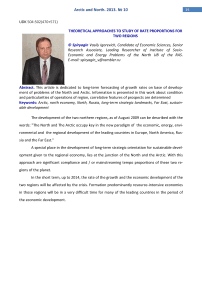Theoretical approaches to study of rate proportions for two regions
Автор: Spiryagin V.I.
Журнал: Arctic and North @arctic-and-north
Рубрика: Regionology of Arctic and North: management, economy, society, culture
Статья в выпуске: 10, 2013 года.
Бесплатный доступ
This article is dedicated to long-term forecasting of growth rates on base of development of problems of the North and Arctic. Information is presented in this work about condition and particularities of operations of region, correlative features of prospects are determined.
Arctic, north economy, North, Russia, long-term strategic landmarks, Far East, sustainable development
Короткий адрес: https://sciup.org/148320368
IDR: 148320368 | УДК: 504:502(470+571)
Текст научной статьи Theoretical approaches to study of rate proportions for two regions
The development of the two northern regions, as of August 2009 can be described with the words: "The North and The Arctic occupy key in the new paradigm of the economic, energy, environmental and the regional development of the leading countries in Europe, North America, Russia and the Far East."
A special place in the development of long-term strategic orientation for sustainable development given to the regional economy, lies at the junction of the North and the Arctic. With this approach are significant compliance and / or mainstreaming tempo proportions of these two regions of the planet.
In the short term, up to 2014, the rate of the growth and the economic development of the two regions will be affected by the crisis. Formation predominantly resource-intensive economies in those regions will be in a very difficult time for many of the leading countries in the period of the economic development.
It is believed that this is largely due to the global changes associated with overcoming the global financial and the economic crisis. However, the financial changes have national and / or regional color, so their impact on the economy of the two regions appear to be different.
Pic 1. The North and The arctic in its boundaries1
More important is the impact of a common energy strategy. Place under the pressure of its economic, social and ecological processes can significantly affect the value of the resource and transport capacities of the North and the Arctic, the course of the spatial development of Russia, as well as a few other northern and Arctic countries. This, of course, can affect the rate of growth, which, in turn, affect the processes of regional differentiation within the two regions and social integration among the major economic powers.
For discussion and effective theoretical and practical solutions under these conditions is necessary, first of all, to recognize the importance of having a number of major development challenges of the northern and the arctic regions, the distinctive features of their economies.
Apply existing of the regional development experience to be adapted, but with the accumulated knowledge and information, in the context of environmental, resource, climate and social changes. Without this adaptation process and the problem of the regional development of the North and Arctic regions in terms of the growth of their economies only lead to greater economic instability.
Should take into account that a significant impact on the development has a degree of the environmental management and the environmental protection in the North and the Arctic. Movement and / or a shift to the north of resource increase the levels of contamination in areas where the natural environment is a modest self-cleaning, which leads to storage of pollutants and additional burden on the economy due to environmental costs, a decrease in quality of life.
For the new macroeconomic conditions for the regions of the North and the Arctic should be developed programs to resolve their specific problems and the strategic priorities. Economy of the northern and the Arctic regions account for the modern processes and generally accept the strategy of the sustainable development. However, the summary comparisons show that the economy of northern countries and regions is offset relative to the market and / or the planned economy. As a result of the country's northern and the arctic regions represent, may not have developed the market, and not the plan, but something else, still not fully analyzed. In such circumstances developed economic programs and the social prescriptions, standard approaches to the observed trends of state, corporate and financial policies must take a distinct northern coloring.
In the modern economic conditions of the northern economy and the Arctic policy must take into account the forced growth of the construction, the spatial distribution of the economic growth rate of the two regions and their orientation with respect to the axis of "North - South" (for example, from Norway to Pakistan), geographical and transport conditions, the contradiction between their spatial dimensions and area, and the extent of favorable climatic conditions for the populations of the two regions.
Reviewer— Zalivskiy Nikolay Pavlovich,


